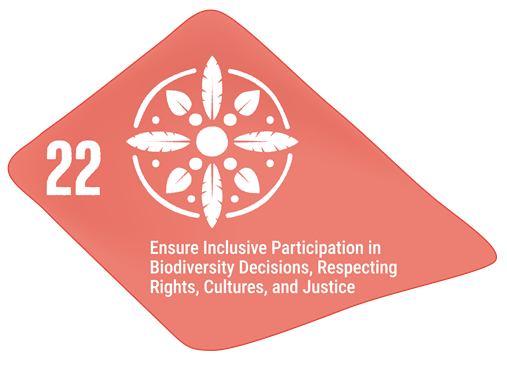 UNCCD
UNCCD
World Day to Combat Desertification and Drought-- 17 June 2024
This year’s World Day to Combat Desertification and Drought spotlights land stewardship.
The theme – “United for land. Our Legacy. Our Future.” – is a recognition that sustainable land management is critical to providing a healthy and sustainable future for all.
This is a responsibility that transcends generations.
Our ancestors cared for the land because they recognized its value.
Today, it is our duty to safeguard land for the next generations.
Young people must be at the centre of our thinking, and they must be at the centre of action.
We must also recognize the pivotal role of indigenous peoples and local communities in land stewardship. Their land rights and meaningful participation in decision-making must be front and centre.
All parts of society must be able to contribute to sustainable land stewardship.
These are powerful notions that can be found at the core of the Kunming-Montreal Global Biodiversity Framework, also known as The Biodiversity Plan.
The Parties to the Convention on Biological Diversity adopted The Biodiversity Plan in December 2022 to halt and reverse biodiversity loss by 2030.
This is a plan for nature stewardship with a vision of living in harmony with nature.
The Plan includes specific targets to manage, protect and restore land.
This year, World Day to Combat Desertification and Drought marks the 30th anniversary of the adoption of our sister convention, the United Nations Convention to Combat Desertification.
Happy anniversary UNCCD!
Let us unite for land. Let us unite for nature. This is our legacy. This is our future.
This year, #DesertificationAndDroughtDay marks the 30th anniversary of the adoption of our sister convention, @UNCCD. Happy anniversary @UNCCD!
— David Cooper (@hdavidcooper) June 17, 2024
Let us unite for land. Let us unite for nature. This is our legacy. This is our future.
Watch my message: pic.twitter.com/OArPi9iNtt
More information:
Dry and Sub-humid Lands Biodiversity
Related Targets in The Biodiversity Plan
Ensure that all areas are under participatory, integrated and biodiversity inclusive spatial planning and/or effective management processes addressing land- and sea‑use change, to bring the loss of areas of high biodiversity importance, including ecosystems of high ecological integrity, close to zero by 2030, while respecting the rights of indigenous peoples and local communities.
Why is this target important?
Land-use and sea-use change are major direct drivers of biodiversity loss. Land-use change has had the largest relative negative impact on terrestrial and freshwater ecosystems since 1970, with agricultural expansion being the most widespread form of land-use change. Marine and coastal ecosystems have been significantly affected by human activities as well, with research demonstrating increasing cumulative impacts of human activities in more than 60 per cent of the ocean.
Increasing demands and conflicting uses of land, inland water and ocean space and resources underscore the need for cross-sectoral approaches that allow for the consideration of multiple interests, values and types of use. Integrated spatial planning and/or effective management processes allow countries to analyze and then effectively allocate the spatial and temporal distribution of activities in each environment to achieve various social, ecological and economic objectives. Integrated and participatory spatial planning helps bring together all stakeholders for a particular space and thereby ensure the prioritization and proper allocation of various activities and thereby balance the need to safeguard nature, while advancing sustainable socioeconomic development and ensuring food security and human well-being. The ecosystem approach as well as the many examples of guidance and experience in implementing this approach also provide a strong basis for this target.
Links to other elements of the Biodiversity Plan and other frameworks and processes.
- Actions to reach Target 1 should take into account all of the considerations for implementation identified in section C of the Kunming-Montreal Global Biodiversity Framework.
- Progress towards this target will support the attainment of goals A and B of the Kunming-Montreal Global Biodiversity Framework. In addition, progress towards this target will directly support the attainment of targets 2, 3, 5, 10 and 12 of the Framework. Conversely, progress towards targets 14, 19, 20, 21, 22 and 23 will help to reach Target 1.
- Target 1 addresses issues that were previously addressed by Aichi Biodiversity Target 5.
- Elements of Target 1 are also addressed in the targets of the Sustainable Development Goals, including targets 14.2, 15.1, 15.2, 15.5 and 15.9.

Ensure that by 2030 at least 30 per cent of areas of degraded terrestrial, inland water, and coastal and marine ecosystems are under effective restoration, in order to enhance biodiversity and ecosystem functions and services, ecological integrity and connectivity.
Why is this target important?
Habitat degradation is the result of human-induced processes that result in a decline in biodiversity, ecosystem functions and services, and resilience and can occur in terrestrial, freshwater or marine and coastal ecosystems. Because degradation can take many forms and be measured in different ways, there are varying estimates on the amount of degraded habitat globally. However, estimates suggest that between 20 and 40 per cent of the global land area alone could be considered degraded, affecting the well-being of at least 3.2 billion people
The main direct drivers of land degradation are the expansion of crop and grazing lands into natural areas, unsustainable agricultural and forestry practices, climate change, and, in specific areas, urban expansion, infrastructure development and extractive industry. Habitat loss through transformation and the decline in the suitability of the remaining habitat through degradation are the leading causes of biodiversity loss. Ecosystems affected by land degradation mainly include forests, rangelands and wetlands. Wetlands are particularly degraded, with 87 per cent lost globally in the last 300 years, and 54 per cent since 1900. Marine ecosystems are experiencing high rates of habitat loss and degradation as well, particularly along coastlines, mangrove forests and coral reefs.
Links to other elements of the Biodiversity Plan and other frameworks and processes.
- Actions to reach Target 2 should take into account all of the considerations for implementation identified in section C of the Kunming-Montreal Global Biodiversity Framework.
- Progress towards this target will support the attainment of goals A and B of the Kunming-Montreal Global Biodiversity Framework. In addition, progress towards this target will directly support the attainment of targets 3, 8, 11 and 12 of the Framework. Conversely, progress towards targets 1, 14, 19, 20, 21, 22 and 23 will help to reach Target 2.
- Target 2 addresses issues that were previously addressed by Aichi Biodiversity Target 15
- Elements of Target 2 are also addressed in the targets of the Sustainable Development Goals, including targets 6.6, 14.2, 15.1 and 15.3
- Target 2 also links to processes under the United Nations Convention to Combat Desertification (UNCCD) related to land degradation neutrality and associated target setting, the Global Forest Goals and targets of the United Nations Strategic Plan for Forests developed under the United Nations Forum on Forests, Ramsar Resolution VII.17 as well as to the United Nations Decade on Ecosystem Restoration.

Ensure that areas under agriculture, aquaculture, fisheries and forestry are managed sustainably, in particular through the sustainable use of biodiversity, including through a substantial increase of the application of biodiversity friendly practices, such as sustainable intensification, agroecological and other innovative approaches contributing to the resilience and long-term efficiency and productivity of these production systems and to food security, conserving and restoring biodiversity and maintaining nature’s contributions to people, including ecosystem functions and services.
Why is this target important?
Agriculture, aquaculture, fisheries and forestry are globally important production systems that have varying impacts on ecosystems and biodiversity. The variety and variability of animals, plants and microorganisms used in these systems is an important aspect of biodiversity. Further, in many countries, activities associated with these production systems are important elements of human well-being and economic activity. However, the increasing demand for food, fibre and fuel is leading to increasing losses of biodiversity and ecosystem services, making sustainable management in these systems an urgent requirement. On the other hand, sustainable management not only contributes to biodiversity conservation but can also deliver benefits to production systems in terms of ecosystem services such as soil fertility, erosion control, enhanced pollination and reduced pest outbreaks, as well as contributing to the well-being and sustainable livelihoods of people engaged in agriculture, aquaculture, fisheries and forestry activities.
Links to other elements of the Biodiversity Plan and other frameworks and processes.
- Actions to reach Target 10 should take into account all of the considerations for the implementation identified in section C of the Kunming-Montreal Global Biodiversity Framework.
- This target will contribute to the attainment of goals A and B of the Kunming-Montreal Global Biodiversity Framework. Further progress towards this target will facilitate the attainment of targets 2, 4, 6, 7, 8, 9, 11 and 16. Conversely, the attainment of this target will be facilitated by actions to reach targets 1, 14, 17, 19, 20, 21, 22 and 23.
- Target 10 addresses issues previously covered by Aichi Biodiversity targets 6 and 7
- Elements of Target 10 are also addressed in the targets of the Sustainable Development Goals, including targets 2.3, 2.4, 12.1, 12.2, 14.7 and 15.2.

Ensure the full, equitable, inclusive, effective and gender-responsive representation and participation in decision-making, and access to justice and information related to biodiversity by indigenous peoples and local communities, respecting their cultures and their rights over lands, territories, resources, and traditional knowledge, as well as by women and girls, children and youth, and persons with disabilities and ensure the full protection of environmental human rights defenders.
Why is this target important?
Indigenous peoples and local communities have a cultural and holistic understanding of nature based on their traditional knowledge, practices and innovation. This information and understanding of biodiversity in turn play a crucial role in the conservation and sustainable use of biodiversity. The insights of indigenous and local communities on local ecosystems play a fundamental role in developing conservation initiatives that integrate cultural values and traditional governance systems, including sustainable use such as resource management techniques, traditional hunting and fishing, and elective harvesting. Further, their lands encompass diverse ecosystems, ranging from forests and wetlands to mountains and coastal areas with high concentrations of biodiversity and often promote sustainable land use, including agroforestry, rotational farming and community-based conservation management systems. Involving indigenous peoples and local communities in biodiversity conservation and the recognition of their perspectives and expertise can contribute to the development of context-specific and effective conservation strategies.
The target also recognizes the importance of meaningful participation of women and girls, as well as the inclusion of children, youth and persons with disabilities, in promoting social equity and empowering these groups to actively contribute to biodiversity conservation. It also highlights the need to protect environmental human rights defenders as they are at the forefront of protecting biodiversity by monitoring and exposing environmental violations, promoting sustainable practices and advocating for a human rights-based approach to conservation efforts.
Links to other elements of the Biodiversity Plan and other frameworks and processes.
- Actions to reach Target 22 should take into account the considerations for implementation identified in section C of the Kunming-Montreal Global Biodiversity Framework.
- Progress towards Target 22 will directly support the attainment of all goals and targets. However, progress towards this target is particularly relevant for the achievement of targets 1, 3, 5, 9, 13, 21 and 23. Conversely, progress towards targets 21 and 23 will support progress towards this target.
- Target 22 addresses issues that were also addressed by Aichi Biodiversity Target 18.
- Elements of Target 22 are also addressed in the targets of the Sustainable Development Goals, including targets 1.4, 5.5, 5.a, 10.2, 10.3, 16.3, 16.7, and 16.10.

Click here for more information about Target 22